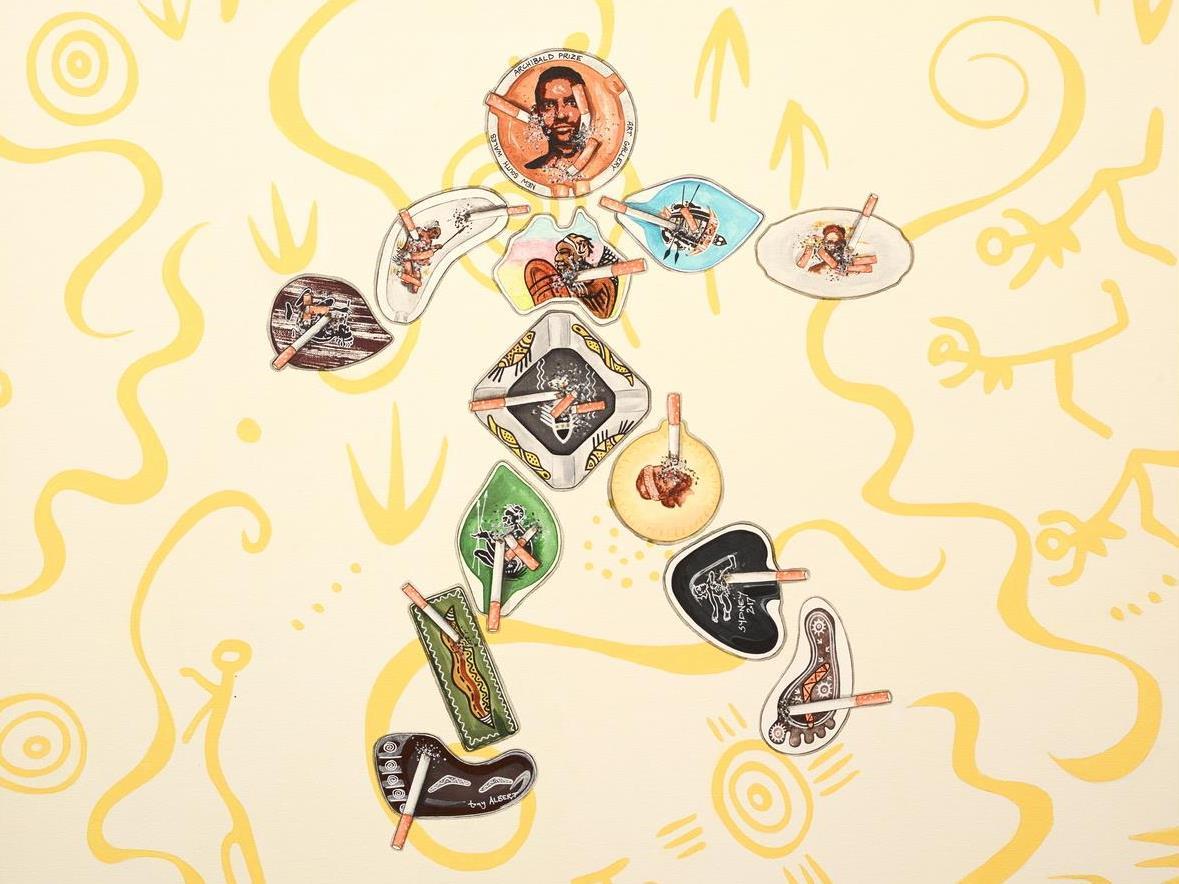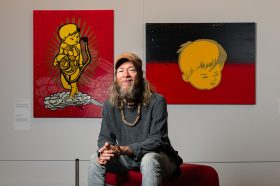Detail from Tony Albert’s Self-portrait (ash on me) acrylic on linen,102 x 102 cm. © the artist Photo: Jenni Carter, AGNSW
The formal announcement of the Packing Room Prize as a preview for the 2017 Archibald is a reminder of how the world has changed. For the last 26 years, Steve Peters and fellow workers in the packing room of the Art Gallery of New South Wales have chosen a favourite painting from the many hundreds of entries for the annual Archibald Prize. Without fail, the painting chosen is realistic in style, with paint applied in smooth layers. More often than not, the subject is either an attractive woman or a media celebrity. This year’s winner, Peter Smeeth’s portrait of Lisa Wilkinson combines both attributes.

Peter Smeeth, Lisa Wilkinson AM, oil on linen, 100x150cm. © the artist Photo: Felicity Jenkins, AGNSW
The aesthetic concerns of those who received the 822 entries in the Archibald are not necessarily the same as those of the Trustees, who by the Will of J.F. Archibald are the only people entitled to judge. The Packing Room Prize came about from the cultural divide between the tastes of the decision makers and the workers who had to carry out their commands. For many years management made it clear that the Packing Room winner was not a finalist, and indeed it was hung just outside the main exhibition.

Lucy Culliton, Finished packing, oil on canvas, 170x145cm. © the artist Photo: Felicity Jenkins, AGNSW
Edmund Capon, the previous director of the gallery, very cleverly turned what was seen by the curators as the worst exhibition of the year into a serious fundraiser and marketing exercise. Visitors are now charged a hefty fee to see the once free exhibition. There are extensive public programs, including celebrity talks and live music.
Then there is the art. This year’s curator, Anne Ryan, has integrated the Archibald with the accompanying Wynne and Sulman exhibitions so that they appear less disjointed. This has enabled her to create a dazzling display of Aboriginal works from the Wynne Prize in the central court, traditionally reserved for the Archibald, and to place the Archibald entries in the more intimate spaces around the court.

Yvette Coppersmith, Professor Gillian Triggs, oil on linen, 137.5 x 110 cm. © the artist Photo: Jenni Carter, AGNSW
Perhaps it is a reflection of the times, but it is now rare to see a politician’s portrait. The best known public figure to make it through to the final 43 is Gillian Triggs, painted by Yvette Coppersmith. The second portrait of a lawyer is Luke William’s study of Remy van de Wiel, the QC who successfully defended those accused of forging work by Brett Whiteley. There is a sense of this lawyer’s flamboyance, not shown in his costume, but in his fly-away hair and prominent spectacles.
These legal portraits join staid studies of prominent men – Robert Hannaford’s portrait of the West Australian businessman Michael Chaney and Paul Newton’s portrait of the philanthropist Rupert Myer. The boys of Sydney Grammar’s Edgecliff Preparatory school have produced what has to be the first entry by school children – as well as the first entry by so many artists – with Goodbye Sir!, a farewell to their headmaster.
Despite the communally created pixelated style, this is nevertheless conceived as a very conservative image. I doubt it will be in the final short-list, but the Archibald is very much an exhibition of social history and it is a great novelty work.
Another “novelty” painting, Sophia Hewson’s Untitled (Richard Bell) places the artist provocateur as Mary Poppins’s chimney sweep in a Walt Disney landscape, complete with Bambi, bluebirds and the hills of the Sound of Music. It’s the kind of painting to bring a smile to even the most jaded visitor.

Sophia Hewson, Untitled (Richard Bell), oil on board, 200x200cm. © the artist Photo: Mim Stirling, AGNSW
The space that holds the dais where speeches are made has Richard Lewer’s Liz Laverty, paying tribute to one of the great patrons of art. The late Colin Laverty and his wife Liz were collectors in the true sense, buying work they admired. They got to know the Indigenous artists whose work they collected, helping remote communities, encouraging others to see what they saw.

Richard Lewer, Liz Laverty, oil on epoxy-coated steel 110 x 110 cm. © the artist Photo: Felicity Jenkins, AGNSW
This is not a “posh” portrait, rather it is painted with a deliberate naivety: just a woman in a black polka dot shirt, looking with love.
Traditionally, Archibald entries (and winners) have been over-large, emphasising the importance of the sitter in the scheme of things. However last year’s winner, Louise Hearman’s intimate portrait, Barry, as well as Sam Leach’s 2010 winner, Tim Minchin, show that size is not necessary for success.
The more intimate spaces of the installation advantage some of the smaller works. Kate Beynon’s self portrait, With amulets and their shadows, references her Chinese heritage with images of Guanyin, the Goddess of Mercy, while her direct gaze quotes Frida Kahlo.

Kate Beynon, With amulets and their shadows, acrylic on wood, 25 x 20 cm. © the artist Photo: Felicity Jenkins, AGNSW
Self portraits are always popular with artists and there are quite a few this year. Madeleine Winch’s Facing the canvas incorporates the artist’s self-examination as a part of her study of her tools of trade. This is appropriate, as Winch often incorporates herself into her work.
My choice for winner
The painting I would like to see win is Tony Albert’s Self-portrait (ash on me). Albert has a long history of re-appropriating kitsch depictions of Aboriginal people, what he calls Aboriginalia. In recent years he has painted studies of ashtrays of kitsch Aboriginal subject matter, complete with stubbed cigarettes. Some of these have been made in collaboration with artists at Hermannsburg, including descendents of Albert Namatjira, whose art was turned to kitsch by commercial exploitation.

Tony Albert, Self-portrait (ash on me) acrylic on linen,102 x 102 cm. © the artist Photo: Jenni Carter, AGNSW
The self-portrait is an arrangement of these ashtrays, with his portrait head painted at the top of the arrangement, complete with two stubbed cigarettes. As an extra twist, this ashtray is captioned “Archibald Prize Art Gallery of New South Wales”.
Albert’s work is deceptively innocent. Each ashtray holds a different aspect of Aboriginality – each is shown as being treated with contempt as a receptacle for dead cigarettes. Yet he manages to make an apparently light-hearted portrait. It is such a clever work.
In the next week, the Trustees will come to the gallery to consider which of these finalists will gain the prize. The voting will take place on Friday morning. If they disagree, the final vote might be taken only minutes before the announcement (in 1996, it was delayed by about 30 minutes as some trustees found it hard to vote for Wendy Sharpe’s Diana of Erskinville). Then the circus will begin.
![]() The Archibald Prize exhibition opens on Saturday 29 July, and is on view until 22 October.
The exhibition will then tour in NSW and Victorian regional cities.
Geelong Gallery 28 October 2017 – 10 December 2017
Murray Art Museum Albury 15 December 2017 – 28 January 2018
Grafton Regional Gallery 2 February 2018 – 18 March 2018
Casula Powerhouse Arts Centre 24 March 2018- 6 May 2018
Newcastle Art Gallery 11 May 2018 – 24 June 2018
Gouburn Regional Art Gallery 30 June 2018 – 18 August 2018
Glasshouse Port Macquarie 25 August – 7 October 2018
The Archibald Prize exhibition opens on Saturday 29 July, and is on view until 22 October.
The exhibition will then tour in NSW and Victorian regional cities.
Geelong Gallery 28 October 2017 – 10 December 2017
Murray Art Museum Albury 15 December 2017 – 28 January 2018
Grafton Regional Gallery 2 February 2018 – 18 March 2018
Casula Powerhouse Arts Centre 24 March 2018- 6 May 2018
Newcastle Art Gallery 11 May 2018 – 24 June 2018
Gouburn Regional Art Gallery 30 June 2018 – 18 August 2018
Glasshouse Port Macquarie 25 August – 7 October 2018
Joanna Mendelssohn, Honorary Associate Professor, Art & Design: UNSW Australia. Editor in Chief, Design and Art of Australia Online, UNSW
This article was originally published on The Conversation. Read the original article.





